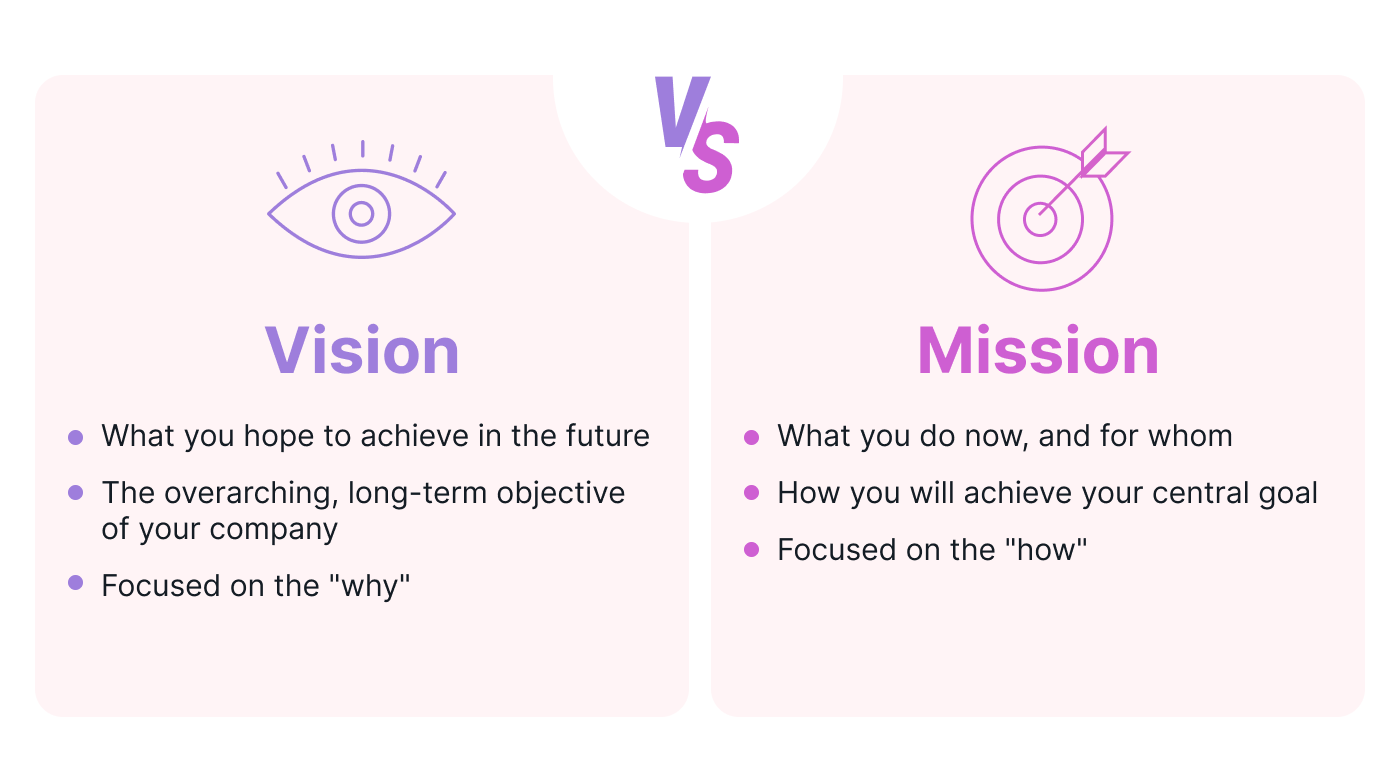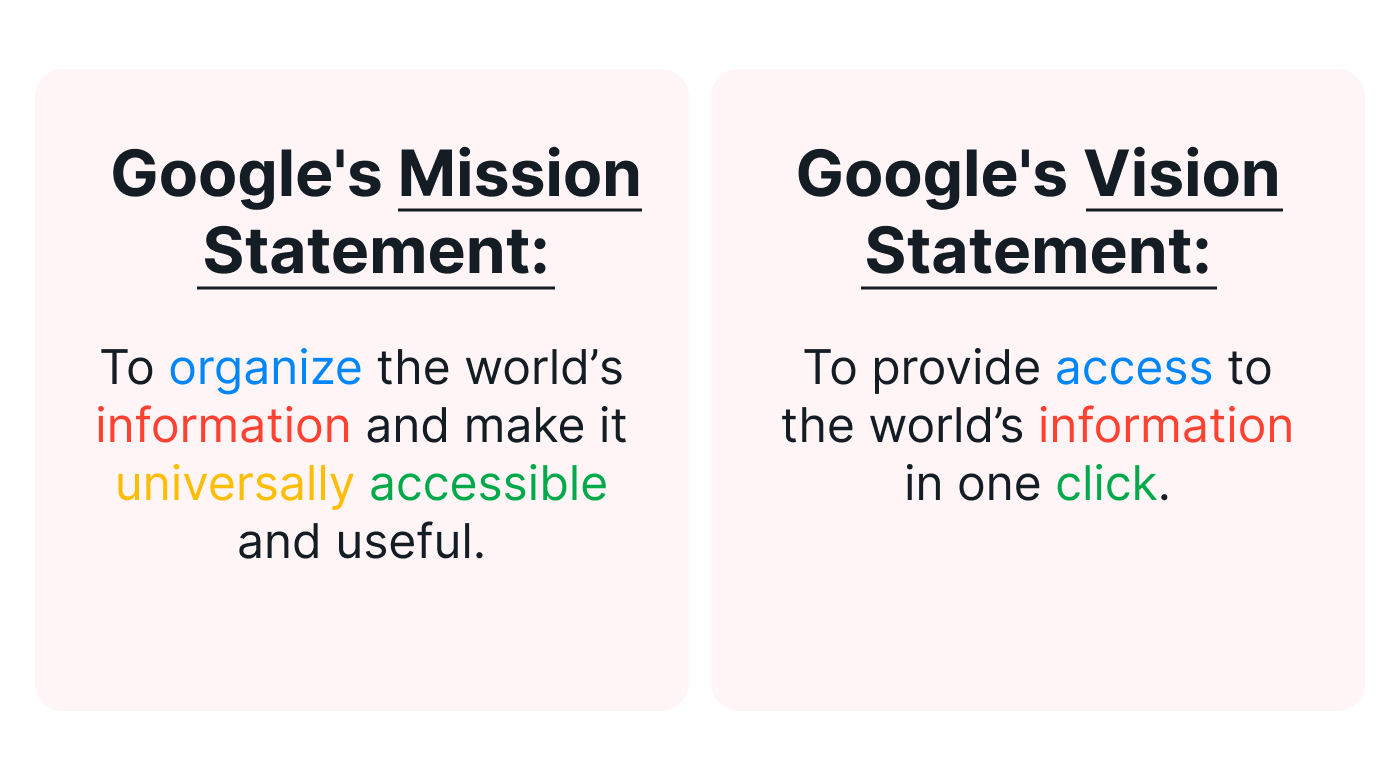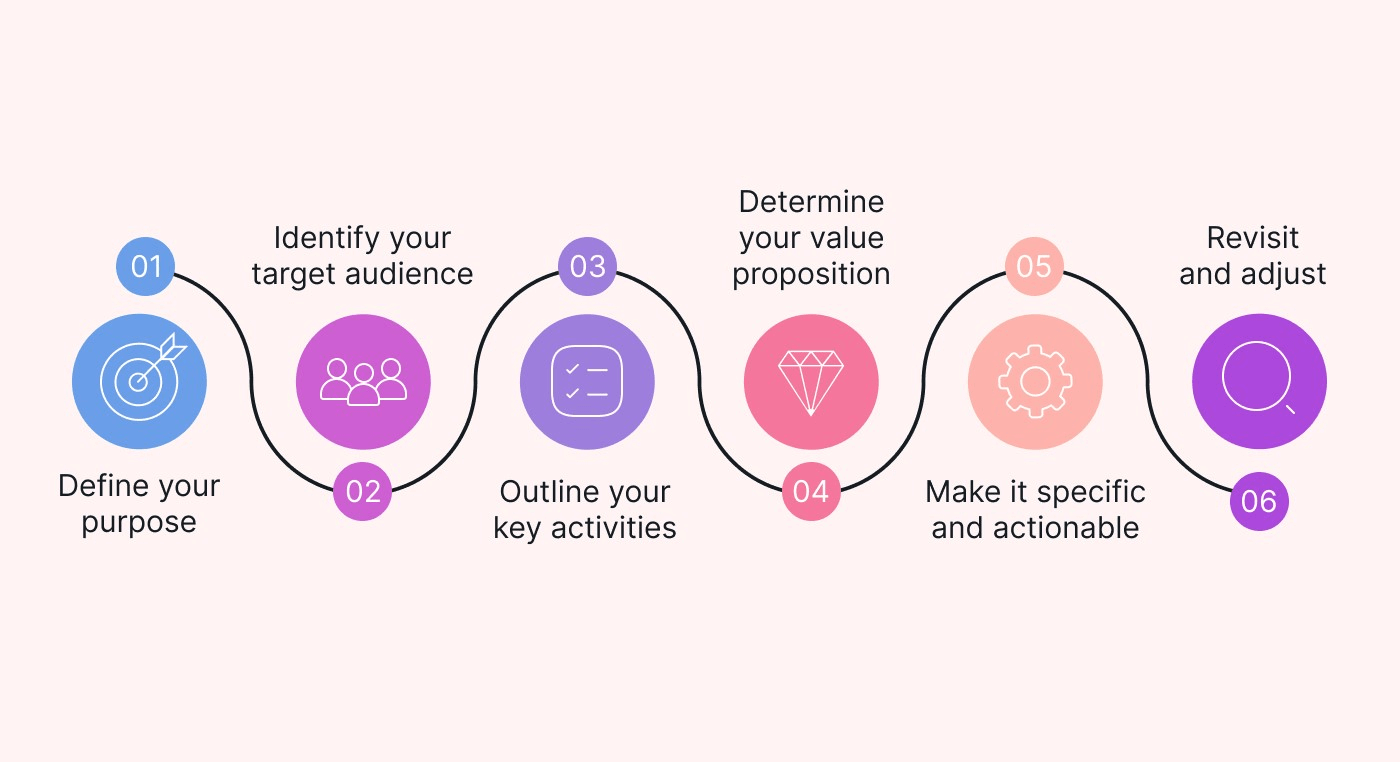In the dynamic world of business, you’ve probably heard the terms “vision” and “mission” being thrown around. But are these really more than buzzwords? And how exactly do they differ?
Understanding the distinction between a company’s vision and mission is essential. These two key components form the backbone of an organization’s identity and purpose, guiding its every move.
In this article, we break down these two concepts, demystify their differences, and shed light on why both of them are crucial elements in any successful organization.
What is a vision statement?
A vision statement is a declaration or concept that describes what an individual or organization hopes to achieve in the future. It outlines the future state that the individual or organization aims to reach.
A company’s vision is meant to motivate employees toward a shared purpose and provide a sense of direction for getting there.
What is a mission statement?
A mission statement is a declaration that outlines the reason an organization exists. It clearly states what the organization does, whom it serves, and how it operates.
The mission statement should be able to describe the organization’s function and approach to its goals. Ultimately, it serves as a guide, helping everyone in the company work together toward common goals and objectives.
Why vision and mission statements matter
Vision and mission statements are crucial guiding principles for any organization. They articulate the company’s purpose, path, and values, both internally and externally.
Internally, these statements serve multiple key functions. They guide strategic thinking — especially during times of change — and define performance standards. They also inspire employees by providing focus and shared goals to guide their decision-making processes. Furthermore, they establish a framework for ethical behavior, promoting a positive and productive work environment.
Externally, vision and mission statements build bridges with different stakeholders. They are tools for public relations, fostering better communication and creating stronger ties with customers, suppliers, and partners. They also help to enlist external support and understanding.
Differences between vision and mission statements
A key difference between a vision and a mission is that the former focuses on the long-term future state that an organization wants to achieve.
On the other hand, a mission statement focuses on the organization’s current purpose and core activities, outlining both its values and objectives.
 |
Another key difference is that a vision statement is more abstract and general — focused on broader ideas — while a mission statement is more specific and tangible — focused on the organization’s activities and impact.
5 real vision and mission statement examples
To really grasp the differences between vision and mission statements, it’s helpful to see how they take shape in the real world. Here are some real-life mission and vision statement examples from well-known organizations that will (hopefully) inspire your own.
1. Tesla
Vision statement: “To accelerate the world’s transition to sustainable energy.”
Mission statement: “To accelerate the world’s transition to sustainable energy with a range of electric vehicles and energy generation and storage products.”
2. Microsoft Corporation
Vision statement: “Our vision is to help people and businesses throughout the world realize their full potential.”
Mission statement: “Our mission is to empower every person and every organization on the planet to achieve more.”
3. Nike
Vision statement: “To bring inspiration and innovation to every athlete* in the world (*If you have a body, you are an athlete.)”
Mission statement: “To unite the world through sport to create a healthy planet, active communities, and an equal playing field for all.”
4. Coca-Cola
Vision statement: “To refresh the world in mind, body, and spirit.”
Mission statement: “To refresh the world in mind, body, and spirit, and inspire moments of optimism; to create value and make a difference.”
5. Google
Vision statement: “To provide access to the world’s information in one click.”
Mission statement: “To organize the world’s information and make it universally accessible and useful.”
 |
How to create a vision statement
As a reminder, a vision statement is future-oriented, outlining an inspiring goal that the organization aims to achieve. When crafting it, ensure that it is aspirational and forward-looking.
Ready to create your own vision? Here’s a six-step process for writing a great vision statement:
1. Define your purpose
Understand the reason your organization exists or its cure purpose. Consider questions like the following:
- What drives you?
- What problems do you aim to solve?
- How can you make a positive impact?
Defending and communicating this purpose with employees is more important now than ever. Research shows that employees today are looking for a sense of purpose in their careers. They want a work environment where they can align their personal life’s purpose with the purpose of the organization they work for.
2. Envision the future
Imagine the ideal future state you want to achieve. Think about where you want to be in the long term, considering both internal and external factors. Visualize what success looks like for you and your team and what you want to accomplish.
 |
3. Identify core values and principles
Decide on the guiding principles and company values that will shape your vision and define the way you want to operate. These core values will provide a framework for your decision-making and help create a positive company culture.
4. Make it specific and inspirational
Refine your vision statement to ensure it’s concise, memorable, specific, and inspirational. Use clear language that conveys your desired future state for your organization. Your vision statement should ignite passion and enthusiasm, both internally and externally.
5. Get input from employees and stakeholders
Ask for input from your employees and investors, taking into account their expectations and needs. Ensure that your vision aligns with their interests and addresses their concerns.
6. Review and revise
Regularly review your vision statement to ensure that it remains relevant and aligned with changing circumstances. Revise it as necessary to reflect new goals, challenges, or opportunities.
How to create a mission statement
Here’s a comprehensive, six-step process you can follow to craft an exceptional mission statement:
 |
1. Define your purpose
Like a vision statement, creating a mission statement starts with understanding why your organization exists. But for a mission statement, defining your purpose involves focusing on the present state of the organization. It’s about pinpointing the reason for the organization’s existence right now.
What problems is your organization currently solving? How is it serving its customers or community today?
2. Identify your target audience
Determine who you are serving or who needs the product or service that you offer. Consider what problems or needs your product or service addresses and who benefits from it.
3. Outline your key activities
Identify the key activities that will help you achieve your purpose. Consider the products or services you offer, the markets or customer segments you operate in, and the channels you use to reach customers.
4. Determine your value proposition
Determine what sets your product or service apart from competitors on the market. Consider your unique selling points, your brand values, and how your offering benefits your customers.
5. Make it specific and actionable
Refine your mission statement to ensure it is concise, memorable, and specific. Use clear language that conveys what you do, who you serve, and how you do it. Avoid vague or generic statements.
6. Revisit and adjust
As you do with your vision statement, regularly revisit your mission statement to ensure it is kept up to date based on your organization’s position.
What comes next?
Once you’ve crafted your mission and vision statements, the next step is to transform that vision into action to propel your mission forward. This requires a thoughtful and strategic approach to bring your aspirations to life.
With your mission and vision statements as the guiding light, take the following steps:
1. Set goals and perform strategic planning
Develop specific goals and objectives that align with the organization’s vision and mission. These goals should be actionable and measurable so that progress can be tracked. Use strategic planning techniques, such as SWOT analysis or SMART goals, to ensure your goals are realistic and achievable.
2. Create an action plan
Break the goals down into actionable steps and activities. Assign responsibilities and timelines to individuals or teams to ensure accountability. Create a roadmap that outlines the necessary actions for achieving the goals and ensures that progress is made toward the vision and mission.
Motion’s AI Project Management App is an intuitive tool that can help you create a high-level roadmap for your team. It visually organizes your project tasks on one platform, giving you and your team a broad view of each project and its progress.
3. Allocate resources
Determine the budget, staffing needs, and technology requirements to effectively execute your plan. Ensure that your resources are aligned with the organization’s priorities and are used efficiently.
 |
Motion makes resource planning a breeze by harnessing the power of AI. It automatically builds your team’s schedule, allocates available resources, and assigns tasks to team members at optimal times. It also analyzes factors like deadlines, working hours, and task dependencies for you so that you can focus on achieving your goals.
4. Implement and monitor your plan
Begin executing your plan of action by carrying out the identified activities and initiatives. Monitor your progress regularly, and track key performance indicators (KPIs) to measure the organization’s progress toward its goals.
5. Evaluate and adapt
Regularly assess your organization’s performance against its goals and review your vision and mission statement to ensure they are still relevant. Consider the impact of your team’s actions, and make adjustments as needed. Ask for feedback from stakeholders — both internal and external — and make improvements based on their feedback.
Turn your vision and mission into action
While vision and mission statements serve different purposes, they are equally important — not to mention inherently connected. They both serve as guides that shape the course of an organization.
And Motion is a powerful tool to keep your organization in sync and on track.
Motion’s collaborative features help team members stay on top of large, complex projects. Automatic task management and project tracking enable individuals to share their progress and monitor the status of everyone’s tasks. This fosters collaboration and ensures that everyone is working toward achieving a clearly defined vision and mission.
Transform your vision and mission into reality with Motion’s trusted productivity platform. Try Motion for free for 7 days.





